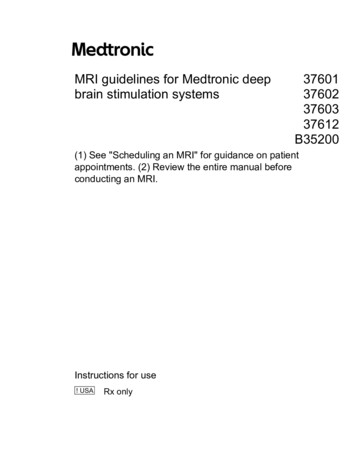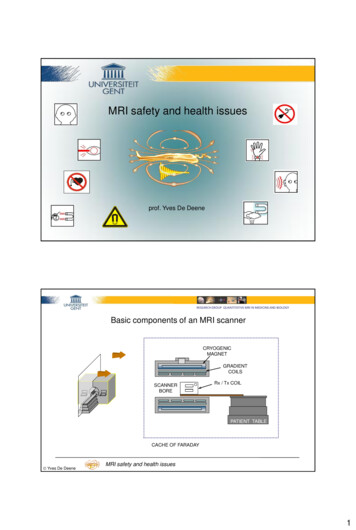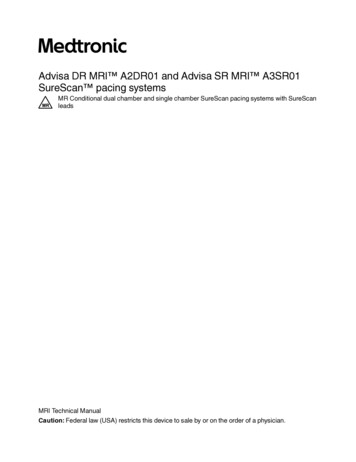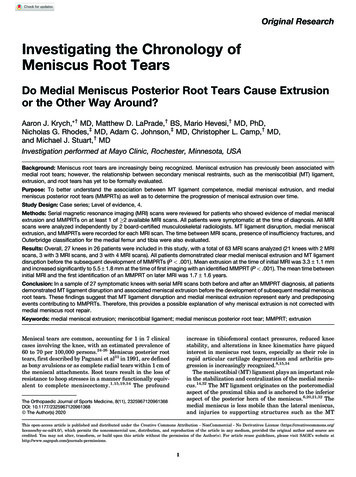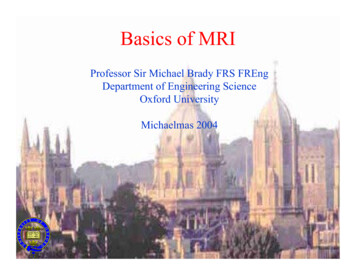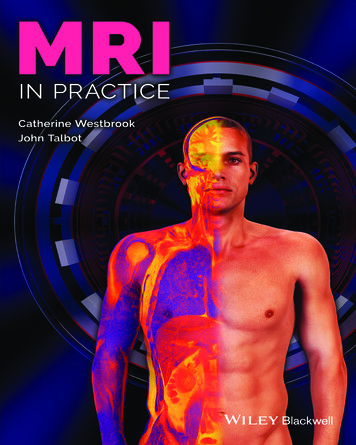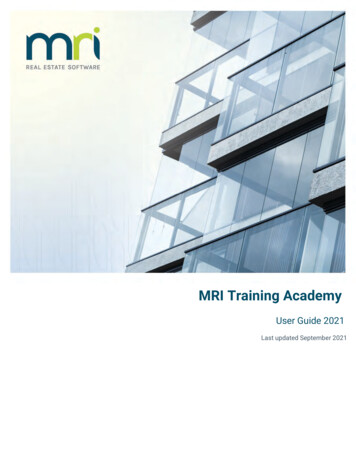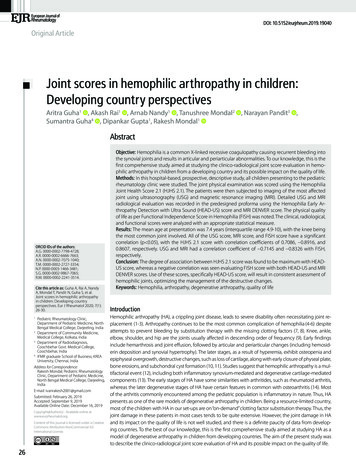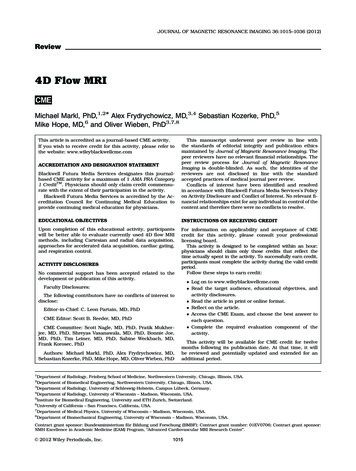
Transcription
CMEJOURNAL OF MAGNETIC RESONANCE IMAGING 36:1015–1036 (2012)Review4D Flow MRIMichael Markl, PhD,1,2* Alex Frydrychowicz, MD,3,4 Sebastian Kozerke, PhD,5Mike Hope, MD,6 and Oliver Wieben, PhD3,7,8This article is accredited as a journal-based CME activity.If you wish to receive credit for this activity, please refer tothe website: www.wileyblackwellcme.comBlackwell Futura Media Services designates this journalbased CME activity for a maximum of 1 AMA PRA Category1 CreditTM. Physicians should only claim credit commensurate with the extent of their participation in the activity.Blackwell Futura Media Services is accredited by the Accreditation Council for Continuing Medical Education toprovide continuing medical education for physicians.This manuscript underwent peer review in line withthe standards of editorial integrity and publication ethicsmaintained by Journal of Magnetic Resonance Imaging. Thepeer reviewers have no relevant financial relationships. Thepeer review process for Journal of Magnetic ResonanceImaging is double-blinded. As such, the identities of thereviewers are not disclosed in line with the standardaccepted practices of medical journal peer review.Conflicts of interest have been identified and resolvedin accordance with Blackwell Futura Media Services’s Policyon Activity Disclosure and Conflict of Interest. No relevant financial relationships exist for any individual in control of thecontent and therefore there were no conflicts to resolve.EDUCATIONAL OBJECTIVESINSTRUCTIONS ON RECEIVING CREDITUpon completion of this educational activity, participantswill be better able to evaluate currently used 4D flow MRImethods, including Cartesian and radial data acquisition,approaches for accelerated data acquisition, cardiac gating,and respiration control.For information on applicability and acceptance of CMEcredit for this activity, please consult your professionallicensing board.This activity is designed to be completed within an hour;physicians should claim only those credits that reflect thetime actually spent in the activity. To successfully earn credit,participants must complete the activity during the valid creditperiod.Follow these steps to earn credit:ACCREDITATION AND DESIGNATION STATEMENTACTIVITY DISCLOSURESNo commercial support has been accepted related to thedevelopment or publication of this activity. Log on to www.wileyblackwellcme.com Read the target audience, educational objectives, andactivity disclosures. Read the article in print or online format. Reflect on the article. Access the CME Exam, and choose the best answer toeach question. Complete the required evaluation component of theactivity.Faculty Disclosures:The following contributors have no conflicts of interest todisclose:Editor-in-Chief: C. Leon Partain, MD, PhDCME Editor: Scott B. Reeder, MD, PhDCME Committee: Scott Nagle, MD, PhD, Pratik Mukherjee, MD, PhD, Shreyas Vasanawala, MD, PhD, Bonnie Joe,MD, PhD, Tim Leiner, MD, PhD, Sabine Weckbach, MD,Frank Korosec, PhDAuthors: Michael Markl, PhD, Alex Frydrychowicz, MD,Sebastian Kozerke, PhD, Mike Hope, MD, Oliver Wieben, PhDThis activity will be available for CME credit for twelvemonths following its publication date. At that time, it willbe reviewed and potentially updated and extended for anadditional period.1Department of Radiology, Feinberg School of Medicine, Northwestern University, Chicago, Illinois, USA.Department of Biomedical Engineering, Northwestern University, Chicago, Illinois, USA.3Department of Radiology, University of Schleswig-Holstein, Campus Lübeck, Germany.4Department of Radiology, University of Wisconsin – Madison, Wisconsin, USA.5Institute for Biomedical Engineering, University and ETH Zurich, Switzerland.6University of California – San Francisco, California, USA.7Department of Medical Physics, University of Wisconsin – Madison, Wisconsin, USA.8Department of Biomechanical Engineering, University of Wisconsin – Madison, Wisconsin, USA.2Contract grant sponsor: Bundesministerium für Bildung und Forschung (BMBF); Contract grant number: 01EV0706; Contract grant sponsor:NMH Excellence in Academic Medicine (EAM) Program, ‘‘Advanced Cardiovascular MRI Research Center’’.C 2012 Wiley Periodicals, Inc.V1015
1016Traditionally, magnetic resonance imaging (MRI) of flowusing phase contrast (PC) methods is accomplished usingmethods that resolve single-directional flow in two spatialdimensions (2D) of an individual slice. More recently,three-dimensional (3D) spatial encoding combined withthree-directional velocity-encoded phase contrast MRI(here termed 4D flow MRI) has drawn increased attention.4D flow MRI offers the ability to measure and to visualizethe temporal evolution of complex blood flow patternswithin an acquired 3D volume. Various methodologicalimprovements permit the acquisition of 4D flow MRI dataencompassing individual vascular structures and entirevascular territories such as the heart, the adjacent aorta,the carotid arteries, abdominal, or peripheral vesselswithin reasonable scan times. To subsequently analyze theflow data by quantitative means and visualization of complex, three-directional blood flow patterns, various toolshave been proposed. This review intends to introduce currently used 4D flow MRI methods, including Cartesian andradial data acquisition, approaches for accelerated data acquisition, cardiac gating, and respiration control. Based onthese developments, an overview is provided over thepotential this new imaging technique has in different partsof the body from the head to the peripheral arteries.Key Words: 4D flow MRI; blood flow; phase contrast; respiration control; PC-VIPR; self-gating; intracranialarteries; carotid bifurcation; aorta; pulmonary arteries;heart; hepatic arteries; renal arteries; peripheral arteries;hemodynamicsJ. Magn. Reson. Imaging 2012;36:1015–1036.C 2012 Wiley Periodicals, Inc.VCARDIOVASCULAR MAGNETIC RESONANCE IMAGING (MRI) has undergone substantial developmentsover the last decades and offers capabilities for evaluating cardiac anatomy and function including cardiacviability, perfusion, blood flow, and vascular anatomy.Phase contrast (PC) MRI can be used to measureand quantify pulsatile blood flow in the human vascular system. The basic principle was introduced byCarr and Purcell in 1954 (1), who reported the firstobservation of coherent motion on the MR-signal, andby Hahn in 1960 (2), who applied flow-sensitive MRIto detect seawater motion. The first in vivo velocitymap images and applications were reported in theearly 1980s (3–6). Since then, two-dimensional (2D)and time-resolved (electrocardiogram [ECG]-gated‘‘CINE’’ imaging) PC MRI has become available on allmodern MR systems and is an integral part of clinicalprotocols assessing blood flow and cardiac and valvefunction in the heart and large vessels (7,8).Recent developments permit the comprehensive acquisition and analysis of blood flow dynamics with fullvolumetric coverage of the vascular territory of interest(9–12). By doing so, a posteriori analyses of hemody-Markl et al.namics have become possible. The term ‘‘4D flow MRI’’used in this review article refers to three-dimensional(3D) data acquired in a time-resolved, ECG-gated, manner with velocity encoding in all three spatial directions.3D visualization can be performed in order to depictthe configuration and changes of blood flow patternsbased on the acquired velocity vectors in all three spatial dimensions (13–19). Retrospective quantificationenables a comprehensive analysis of regional cardiacand vascular hemodynamics (20–23). In addition tothe measurements of basic flow volumes and velocities, the estimation of derived hemodynamic biomarkers such as wall shear forces (24–26), pulsewave velocity (27,28), pressure gradients (29–31), andother measures (32,33) have been proposed.The purpose of the review is to introduce the reader tocurrently available acquisition and analysis methodsfor 4D flow MR imaging. We will also provide an overviewover potential clinical applications in various vascularregions throughout the body that have been reported.METHODSPhase Contrast MRI: Basic Principleand Standard TechniquesThe intrinsic sensitivity of MRI toward motion can beused with PC MRI to image vessel anatomy for PC MRangiography (34) but also to directly measure bloodflow velocities. The underlying concept of velocityencoding is based on the observation that changes inthe MR signal phase along a magnetic field gradientare directly related to the blood flow velocity. Usingappropriate bipolar velocity encoding gradients, flowdependent phase changes can be detected by playingout two acquisitions with different velocity-dependentsignal phase but otherwise identical sequence parameters (7,8,35). Subtraction of the two resulting phaseimages (ie, calculation of phase difference images Df)allows for the removal of the unknown backgroundphase and calculation of velocity images. Thisapproach is generally referred to as PC MRI, flow-sensitive MRI, or MR velocity mapping.Standard MR acquisitions are too slow to capturedynamics within the cardiac cycle in real time withsufficient spatial resolution. Instead, the acquisitionis split over multiple heartbeats and data acquisitionhas to be gated to the cardiac cycle using the ECGsignal (eg, the R-wave) or a pulse oximeter reading. Aseries of time-resolved (CINE) images is collected representing the dynamics of the pulsatile blood flowduring the cardiac cycle (7,36,37).Standard techniques use PC MRI methods that provide velocity maps with two spatial dimensions (2D)on individually placed imaging slices. Usually, one-*Address reprint requests to: M.M., Departments of Radiology and Biomedical Engineering, Northwestern University Feinberg School ofMedicine, 737 N. Michigan Ave. Suite 1600, Chicago, IL 60611. E-mail: mmarkl@northwestern.eduReceived August 15, 2011; Accepted February 6, 2012.DOI 10.1002/jmri.23632View this article online at wileyonlinelibrary.com.
4D Flow MRI1017Figure 1. Standard 2D CINE PC MRI with one-directional through-plane (z) velocity encoding. Reference and velocity sensitive scan (added bipolar encoding gradient) are acquired in direct succession. The subtraction of both datasets providesphase difference images that contain quantitative blood flow velocities as shown in a 2D slice normal to the ascending (AAo)and descending (DAo) aorta and including the pulmonary artery (PA). Due to time constraints, the MR data cannot beacquired during a single heartbeat and PC data are collected over several cardiac cycles. The measurement is synchronizedwith the cardiac cycle using an ECG-gated k-space segmented data acquisition. For each heartbeat and time frame only asubset (NSeg) of all required (Ny) phase-encoding steps are measured (k-space segmentation). The procedure is repeated untilthe full raw dataset is acquired and time-resolved (CINE) images can be derived depicting the dynamics of pulsatile throughplane flow. The selection of the number of phase-encoding lines NSeg determines the temporal resolution (time to collect datafor a single time frame Dt ¼ 2 TR NSeg) and a total scan time Tacq ¼ Ny/NSeg TCC of the phase contrast CINE acquisition (TCC ¼duration of one cardiac cycle). For a typical TR on the order of 5–10 msec and NSeg ¼ 3–4, measurements can be performedduring breath-holding and with temporal resolutions of 30–80 msec. Typical velocity sensitivities are Venc ¼ 150 cm/s foraortic flow measurements and Venc ¼ 100 cm/s for flow in the pulmonary artery. The presence of stenosis will require selection of higher velocity sensitivities for properly capturing accelerated flow. [Color figure can be viewed in the online issue,which is available at wileyonlinelibrary.com.]directional (‘‘through plane’’) velocity encoding alongthe predominant blood flow direction is used to quantify blood flow in the heart, through cardiac valves,and in great vessels. A typical data acquisition strategy for standard 2D CINE PC MRI, which can be performed during a single breath hold, is illustrated inFig. 1 (for details on typical imaging parameters seefigure legend).It is important to note that PC MRI requires theuser to define an upper velocity limit, the velocity sensitivity encoding parameter Venc. Venc is defined as the(positive or negative) maximum velocity that can bedetected without error. For velocities exceeding theVenc, velocity aliasing occurs. In this case, the acquisition needs to be repeated with an increased Venc orantialiasing correction needs to be performed toachieve data that can be properly quantified. PC MRIthus requires prior knowledge (approximation) of themaximum velocities that are expected in the vessel ofinterest. The Venc can be flexibly adjusted by the user.Changes in Venc correspond to changing the strengthsand duration of the velocity encoding gradients, wherethe encoding of lower velocities requires larger gradi-ent areas and thus longer echo and repetition times(TE and TR).As for all MR images, the quality of PC velocityimages can be degraded by noise. The velocity noisein PC MRI is directly proportional to the Venc andinversely related to the signal-to-noise ratio (SNR) inthe corresponding magnitude images, ie, vnoise Venc/SNR (7). Hence, both properties of PC-MRI, high Vencto avoid aliasing and low Venc to reduce noise, need tobe considered for the selection of the optimal velocitysensitivity. In essence, the user should choose thehighest expected velocity to avoid unintentional wrapping in the velocity images and check the resultingimage before the patient leaves the scanner. At thesame time keeping the Venc as low as possible willreduce velocity noise and improve image quality.4D Flow MRI: Data AcquisitionFull 3D CINE coverage with three-directional velocityencoding, ie, ‘‘4D flow MRI,’’ can be achieved usingstandard Cartesian or technically more demanding radial image acquisition. Since the acquisition of
1018Markl et al.Figure 2. Schematic illustration of Cartesian 4D flow MRI of the thoracic aorta. For each time frame, four 3D raw datasetsare collected to measure three-directional blood flow velocities (vx, vy, vz) with a reference scan and three velocity-encodedacquisitions. Navigator gating of the diaphragm motion can be used for image acquisition during free breathing. The navigator pulse (NAV) is played out at the end of each cardiac cycle to update the current respiration phase which is used for respiratory gating. K-space segmentation is used to collect a subset (NSeg) of all required (NyNz) phase-encoding steps for eachtime frame. The selection of NSeg determines the temporal resolution Dt ¼ 4 TR NSeg and total scan time Tacq ¼ NyNz/NSegTECG. For applications in the aorta or pulmonary systems a typical TR on the order of 5–6 msec, spatial resolution 2 2 2 mm3, Venc ¼ 100–150 msec, NSeg ¼ 2, parallel imaging with R ¼ 2, navigator efficiency ¼ 50%–80% results in a total scantime of approximately 15–20 minutes with a temporal resolution of 40–50 msec.volumetric data requires considerably longer totalscan times (up to 20 minutes) compared with traditional 2D-CINE-PC, exams can no longer be performed during a breath hold. Therefore, differentstrategies to incorporate respiration control have to beconsidered for thoracic and abdominal 4D flow MRI.Cartesian 4D Flow MRI and Three-DirectionalVelocity EncodingThe need to collect time-resolved volumetric data combined with three-directional velocity encoding requiresan efficient data acquisition to reduce the scan timeto clinically feasible durations. K-space segmentationand interleaved four-point velocity encoding are usedto acquire 3D CINE data in combination with respiratory gating, as illustrated in Fig. 2. As in 2D CINE PCMRI, measurements are based on radiofrequency(RF)-spoiled gradient echo sequences with short TEand TR times. During each cardiac cycle, a subset(NSeg) of all required phase-encoding steps (Ny Nz kspace lines along phase (ky) and slice (kz) encodingdirection) is collected. The procedure is repeated for atotal of NyNz/NSeg heartbeats to achieve full 3D volumetric coverage (11,38).Multiple approaches have been used to performthree-directional flow encoding. The earliest approachwas following the logic that for each encoded velocitydirection a pair of measurements is required. Similarto one-directional velocity encoding in Fig. 1, oneflow-compensated and one flow-encoded measurement per direction resulted in a time-intensive technique that was referred to as a ‘‘six-point method’’(34). Later, and as currently used for 4D flow techniques, more time-efficient ‘‘four-point’’ techniques wereintroduced. As illustrated in Fig. 2, for each singleraw data (k-space) line four successive acquisitionsare collected to achieve velocity encoding in all threedimensions: one reference scan and the three velocityencoded acquisitions (added bipolar gradients alongx-, y-, z-direction). After the data acquisition is completed, image reconstruction yields 3D CINE magnitude data (anatomical images) and three time seriesrepresenting the three-directional blood flow velocities
4D Flow MRIFigure 3. In 3D radial acquisitions, every acquired k-spaceline traverses through the center of k-space (a). The endpoints of the projections cover the surface of a sphere so thatthe resulting imaging volume is a sphere also. With radialundersampling, scan time is reduced at the expense ofstreak-like artifacts and a reduced SNR while spatial resolution is preserved. As shown in the pulse sequence diagram(b), there is no traditional readout gradient, phase-encodinggradient, and slice-encoding gradient in a radial acquisition.The gradient waveforms are scaled with the azimuthal andinclination angle of the projection and bipolar gradient pairsare added for velocity-encoded scans such as PC VIPR.vx, vy, and vz (phase difference images). Interleaved velocity encoding, which requires the successive acquisition of the same phase-encoding line with four different velocity-encoding gradients, results in a lowerlimit for the temporal resolution of Dt ¼ 4 TR. Theselection of the Venc will impose requirements on thearea under of the bipolar velocity-encoding gradientsand thus influence the minimum achievable echo andrepetition times TE and TR. For typical cardiovascularapplications with a Venc ranging between 50–200 cm/sec, the TE and TR can be as low as 2–4 msec and 5–7 msec.In addition to the ‘‘simple’’ (or ‘‘referenced’’) fourpoint method using a single reference scan and a series of three velocity-encoded scans as shown in Fig.2, other ‘‘balanced’’ four-point methods have beenproposed. For a more detailed description, please referto Pelc et al (39), Bernstein et al (35), and Johnsonand Markl (40).Radial 4D Flow MRI (PC-VIPR)Scan times for 4D flow MRI can become prohibitivelylong, especially when high spatial resolution or largevolumetric coverage are preferable. Several methodshave been proposed for reductions in scan timeincluding the use of parallel imaging (41) and sampling strategies that explore correlations in the spatiotemporal domain (42) or both (43).A promising approach for accelerated PC MRI is theuse of radial undersampling. With this approach, datapoints in k-space are recorded on a radial trajectoryas shown in Fig. 3. In a 3D radial acquisition, eachrecorded data line passes through the center of kspace. The resolution along the rotating readout direction remains constant for each projection angle andprovides an isotropic spatial resolution over a spheri-1019cal imaging volume. In contrast to traditional Cartesian sampling with parallel lines in k-space, spatialresolution is preserved even if fewer radial lines areacquired than dictated by the Nyquist limit (44).Instead of a compromised resolution, the tradeoffs forscan time reductions are streak artifacts and a loss ofSNR.It has been shown that PC MRI acquisitions are wellsuited for radial undersampling due to the inherentsubtraction of signal from static tissues (45). Moderate streak artifacts can be tolerated in these imagesthat are characterized by high contrast and sparsesignal distribution from the vessels. A 3D radial flowsensitive acquisition, introduced as PC VIPR (vastlyundersampled isotropic projection reconstruction)(46), provides coverage of a large imaging volume withhigh spatial resolution in all three dimensions. Additional scan time savings can be achieved for cardiacgated acquisitions by temporal filtering (47), whichoffers greater flexibility for ‘‘view sharing’’ of radialdata compared with Cartesian datasets. Non-Cartesian trajectories are more sensitive to several artifactsand the method was refined to minimize trajectoryerrors, off-resonance effects, and aliasing artifactsfrom undersampling (48).Advantages of PC VIPR acquisitions include: 1) isotropic spatial resolution for image reformatting inoblique planes and improved hemodynamic analysis;2) large volume coverage; and 3) high spatial resolution, which also reduces partial volume effects andintravoxel dephasing. Radial sampling has also beenshown to offer several advantages in dealing withmotion: i) the appearance of motion artifacts is generally reduced (49); ii) self gating to the cardiac (50) andrespiratory cycle (51) is possible of the radial signalitself; and iii) retrospective cardiac gating isfacilitated.PC VIPR has been shown to generate high-qualityMR angiograms for vessels of various sizes without acontrast agent (52). It has also been used for hemodynamic analysis in applications that demand high spatial resolution, such as cranial aneurysms (53) andmeasurements of trans-stenotic pressure gradients(54–56); or large volumetric coverage as often neededon congenital heart disease (57); or both includingcranial imaging (58) and imaging of the hepatic andportal venous system (59).Respiration ControlFor thoracic and abdominal applications, patientbreathing can cause data inconsistencies that resultin image ghosting and blurring. Therefore, respiratorygating is usually applied to minimize artifacts. Mostwidely available approaches include bellows readingor navigator gating (60–63). In both, a range or window of accepted and rejected diaphragm positions canbe defined. In the case of bellows reading, the excursion of the upper abdominal circumference serves asthe indirect indicator of the diaphragm position andhence breathing motion. Similarly, navigator gatingcan be used to regularly (eg, for each cardiac cycle)provide information on the diaphragm position during
1020Markl et al.Figure 4. Self-gating principle for Cartesian and radial imaging. Using the total projection concept the central k-space pointis repetitively measured for each time-frame. Since the central k-space point reflects the integral of the object signal withinthe sensitive volume, motion leads to a modulation of k-space signal, which can be directly used for respiratory gating (a,b).In order to add spatial resolution, entire k-space profiles may be imaged such that, upon Fourier transform, spatial resolution along a main component of motion is obtained (c,d). While sequence modification is necessary to repetitively sample thek-space center or a specific profile in Cartesian imaging, which also prolongs TR and/or the duration of a time-frame (a,c), radial scanning inherently samples the k-space center or profiles suitable for self-gating and hence sequence timing remainsunchanged (b,d).the 4D flow MRI data acquisition. For respiratory gating, data are accepted if the current breathing position is within a predefined end-expiratory or endinspiratory window. Otherwise, data collected duringthe current cardiac cycle are rejected and the acquisition is repeated until the gating criteria have beenmet. A certain amount of data, typically 40%–60%, isthus rejected thereby prolonging the total exam timecompared with nonrespiratory-gated 4D flow MRIacquisitions. Adaptive k-space reordering, ie, phaseencoding based on the current position in the respiration cycle, can reduce data rejection to 20%–40%(38,64,65).Advanced Physiological ControlWhile navigator gating based on 1D measurements ofdiaphragm motion has been widely adopted for 4Dflow measurements by most vendors, it has two drawbacks. First, detection of motion of the organ of interest is typically based on measurements of remoteanatomy. For example, in cardiac imaging respiratory-induced motion of the heart is typically inferredfrom measurements of displacement of the lung–liverinterface (60). It has been demonstrated that the relation between heart and liver motion may be offsetand, consequently, correction factors to account fordeformation (66) and respiratory hysteresis (67) havebeen proposed. A second drawback relates to the timeit takes to acquire navigator data, which only permitsa single or two navigators per cardiac cycle in mostsituations. It has been shown that this low temporalupdate can lead to a poor prediction of respiratorymotion for the cardiac phases acquired long after anavigator signal (63).In addressing these shortcomings, respiratory selfgating methods have been proposed (50,68,69) thatrepetitively acquire k-space data of the object itself toprovide information of object motion (Fig. 4). Self-gating methods re-visit the central k-space point or specific profiles in each time-frame of the cardiac cycle,and hence sample respiratory induced signal fluctuation at a high temporal rate. Sampling the central kspace point provides the integral of the entire objectsignal within the sensitive imaging volume. Accordingly, the amplitude is modulated as the object movesrelative to the receive antennae used.Such an approach adds only little time to eachtime-frame in Cartesian imaging but it may be compromised in patients with significant body fat, as thebright fat signal may mask motion-induced signalchanges of the object of interest. Accordingly, self-gating methods have been extended to measure entireprofiles oriented such that major components ofmotion are captured with 1D projections (51,70). InCartesian cine imaging this, however, leads to areduction of the number of time-frames that can beacquired during a cardiac cycle, as one additional TRis required per time-frame to measure projections.While the additional sampling of a single k-spacepoint or entire profiles in Cartesian imaging prolongsthe duration of each time-frame, radial imaging methods offer an elegant approach to inherently acquiremotion-related information without time penalty (51).In combination with PC-VIPR and related Goldenangle radial imaging techniques (71), these self-gating
4D Flow MRI1021Figure 5. PC-MRA of a 5-minute cranial PC VIPR scan acquired with a Venc of 80 cm/s (a) and 25 cm/s (b). A 3D PC-MRA isderived from combining the magnitude and velocity data, most commonly achieved by complex difference processing. Theresulting angiogram suppresses signal from nonmoving tissue and shows the vessel lumens of arteries and veins. Theseangiograms can be used for vessel segmentation and processing of the velocity data and to provide an alternative to MR angiography approaches that rely on the injection of a contrast bolus. A lower Venc setting (b) provides higher SNR and better visualization of vessels with slower blood flows such as veins and smaller arteries.approaches seem most promising to provide motioninformation for respiratory gating purposes.As respiratory gating leads to partial rejection ofdata acquired during rapid motion, overall scan efficiency is typically reduced by 20%–60% leading tolong overall measurement times in 4D flow imaging.Advanced retrospective motion correction techniqueshave been developed that permit correction of theacquired data given an estimate of the underlyingmotion (72). Motion estimates may be obtained fromsimultaneous recordings from respiratory belts, selfgating signals, or navigators (73). While most self-gating and advanced motion correction methods havebeen applied to cine imaging, their application to 4Dflow imaging remains to be accomplished.4D Flow MRI: Data Postprocessing and AnalysisSeveral sources of error such as background phasecontributions from eddy-currents or method-specificproblems such as velocity aliasing and noise can compromise MR velocity maps and need to be addressedprior to data processing or visualization. The majorsources of errors include eddy current effects, Maxwell terms, and gradient field distortions. Appropriatecorrection strategies have been presented and validated in the literature and should be applied toensure accurate 3D visualization and flow quantification using 4D flow MRI data. More details regardingappropriate correction strategies can be found inWalker et al (eddy currents) (74), Bernstein et al (Maxwell terns) (75), and Markl et al (gradient field nonlinearity) (76).The complex nature of the 4D flow MRI data (threespatial dimensions, three velocity directions, and timewithin the cardiac cycles) imposes the challenge totranslate the multidimensional information intoimages that can clearly depict the underlying anatomic and functional information. The combination ofangiographic data (3D PC-MRA) and 3D blood flowvisualization, which can both be derived from the 4Dflow data, can be powerful tools to efficiently displayvascular anatomy and blood flow in 3D and over time(see, eg, Figs. 6, 7) (14).PC-MR AngiographyPhase contrast imaging has been used to generate MRangiograms (PC MRAs) since the early days of clinicalMRI (34). Interest in diagnostic PC MRA was recentlyrenewed by discovering a link between nephrogenicsystemic fibrosis (NSF) and gadolinium-based MRAcontrast agents (77) as well as the greatly improved 4Dflow MRI acquisitions. In addition, the hemodynamicvisualization and analysis of 4D flow MRI data greatlybenefits from the availability of a detailed angiogram,specifically for proper segmentation of vessels.There are several strategies for calculating angiograms from acqui
EDUCATIONAL OBJECTIVES Upon completion of this educational activity, participants . JOURNAL OF MAGNETIC RESONANCE IMAGING 36:1015-1036 (2012) CME VC 2012 Wiley Periodicals, Inc. 1015. . In this case, the acquisi-tion needs to be repeated with an increased V enc or
